Change in anthropometric parameters of the posture of students of physiotherapy after three years of professional training
- PMID: 24587989
- PMCID: PMC3920915
- DOI: 10.1155/2014/719837
Change in anthropometric parameters of the posture of students of physiotherapy after three years of professional training
Abstract
Introduction and aim: A physiotherapist's occupation requires high physical fitness and a properly functioning neuromuscular system. Working with patients is not always performed in accordance with the rules of work ergonomics. The aim of this paper was to verify the possible changes in the posture of students of physiotherapy after three years of professional training.
Material and methods: The sample group consisted of 30 randomly chosen students of physiotherapy. Each person was examined twice (at the age of 20 and at the age of 23). Both examinations were performed by the same researcher. The ultrasound system ZEBRIS Pointer was used for the examination; 17 parameters were analyzed in sagittal projection, frontal projection, and transversal projection.
Results: Statistical analysis revealed positive correlations between the 10 parameters in examination 1 and examination 2 which means that a person with a relatively higher level of obliquity in examination number 1 also had slightly different values in an examination conducted three years later.
Conclusion: Studying physiotherapy and physical work with patients resulted in a considerable worsening of the students' posture. It is advisable to educate students on ergonomics and the rules of safety and hygiene while working as a physiotherapist in order to protect the therapists' health.
Figures
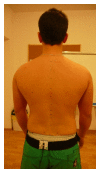

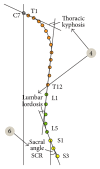
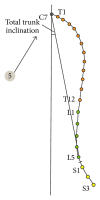
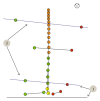
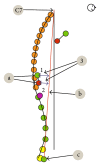
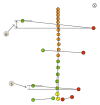









Similar articles
-
Physiotherapy students' self-reported assessment of professional behaviours and skills while working with young people with disability.Disabil Rehabil. 2014;36(21):1834-9. doi: 10.3109/09638288.2013.871355. Epub 2013 Dec 26. Disabil Rehabil. 2014. PMID: 24369103
-
Learning about health promotion through behavior change: a novel qualitative study of physiotherapy students incorporating applied intervention and reflection.Physiother Theory Pract. 2021 Apr;37(4):497-506. doi: 10.1080/09593985.2019.1630876. Epub 2019 Jun 18. Physiother Theory Pract. 2021. PMID: 31210562
-
[The improvement of the abilities to maintain motor coordination and equilibrium in the students presenting with the functional disorders of the musculoskeletal system by introducing the elements of therapeutic physical training into the structure of academic schedule of physical education].Vopr Kurortol Fizioter Lech Fiz Kult. 2017;94(1):36-40. doi: 10.17116/kurort201794136-40. Vopr Kurortol Fizioter Lech Fiz Kult. 2017. PMID: 28374730 Russian.
-
Effectiveness of high fidelity simulation versus low fidelity simulation on practical/clinical skill development in pre-registration physiotherapy students: a systematic review.JBI Database System Rev Implement Rep. 2019 Jun;17(6):1229-1255. doi: 10.11124/JBISRIR-2017-003931. JBI Database System Rev Implement Rep. 2019. PMID: 30964770
-
Anthropological research in reference to ergonomics.J Physiol Anthropol Appl Human Sci. 2005 Jul;24(4):517-9. doi: 10.2114/jpa.24.517. J Physiol Anthropol Appl Human Sci. 2005. PMID: 16079610 Review.
Cited by
-
The assessment of procedural skills in physiotherapy education: a measurement study using the Rasch model.Arch Physiother. 2020 May 25;10:9. doi: 10.1186/s40945-020-00080-0. eCollection 2020. Arch Physiother. 2020. PMID: 32509329 Free PMC article.
-
Evaluation of Anterior-Posterior Spine Curvatures and Incidence of Sagittal Defects in Children and Adolescents Practicing Traditional Karate.Biomed Res Int. 2019 Apr 28;2019:9868473. doi: 10.1155/2019/9868473. eCollection 2019. Biomed Res Int. 2019. PMID: 31183382 Free PMC article.
-
Interrelationship between postural balance and body posture in children and adolescents.J Phys Ther Sci. 2017 Jul;29(7):1154-1158. doi: 10.1589/jpts.29.1154. Epub 2017 Jul 15. J Phys Ther Sci. 2017. PMID: 28744036 Free PMC article.
-
The Influence of Body Mass Composition on the Postural Characterization of School-Age Children and Adolescents.Biomed Res Int. 2018 Oct 14;2018:9459014. doi: 10.1155/2018/9459014. eCollection 2018. Biomed Res Int. 2018. PMID: 30406147 Free PMC article.
-
Concurrent validity of photogrammetric and inclinometric techniques based on assessment of anteroposterior spinal curvatures.Eur Spine J. 2018 Feb;27(2):497-507. doi: 10.1007/s00586-017-5409-8. Epub 2017 Nov 28. Eur Spine J. 2018. PMID: 29185110
References
-
- Grabara M. Hearing dysfunctions and body posture’s asymmetry. Polish Journal of Physiotherapy. 2006;6(2):121–125.
-
- Kluszczyńska A, Kujawa J, Janiszewski M, Pieszyński I. Impact of musical performance on the frequency of postural abnormalities in children. Polish Journal of Physiotherapy. 2004;4(2):117–128.
-
- Żychowicz P. Body posture in children and adolescents with eyesight disorder. Problems of Hyg i Epidemiologii. 2008;89(1):67–70.
-
- Zeyland-Malawka E. The practice of a swordsmanship and body posture. In: Ślężyński J, editor. The Body Posture, Its Flaws and Ways to Correction. Materials of IX Congress of Physiotherapy. 1990. pp. 91–106.
-
- Olszewska E, Trzcińska D. The body posture of children and youth in different periods of development. In: Górniak K, editor. Correction and Compensation of Disturbances in the Physical Development of Children and Youth. Vol. 2. Podlaska, Poland: Biała; 2005. pp. 66–74.
MeSH terms
LinkOut - more resources
Full Text Sources
Other Literature Sources
Medical

